MGT600: Addressing Challenges at ComSyst Technology Company Report
VerifiedAdded on 2023/01/19
|20
|4543
|51
Report
AI Summary
This report analyzes ComSyst Technology (CST), a multi-national communications software and system developer facing challenges in employee engagement, performance, and retention. The report, prepared by a consultancy firm, identifies key issues like low employee engagement, poor performance, and a decline in staff retention, impacting CST's market share. It provides recommendations to enhance teamwork, team development, and management. The report suggests implementing an effective performance management system, creating a merit-based and transparent reward system, and boosting training and personal development programs to maximize employee skills. The report aims to help CST build a high-performance work culture, enhance employee capabilities, and position the company for future success by focusing on attracting and retaining skilled workforce, creating a team-based high-performance culture, and building employee capability and performance.
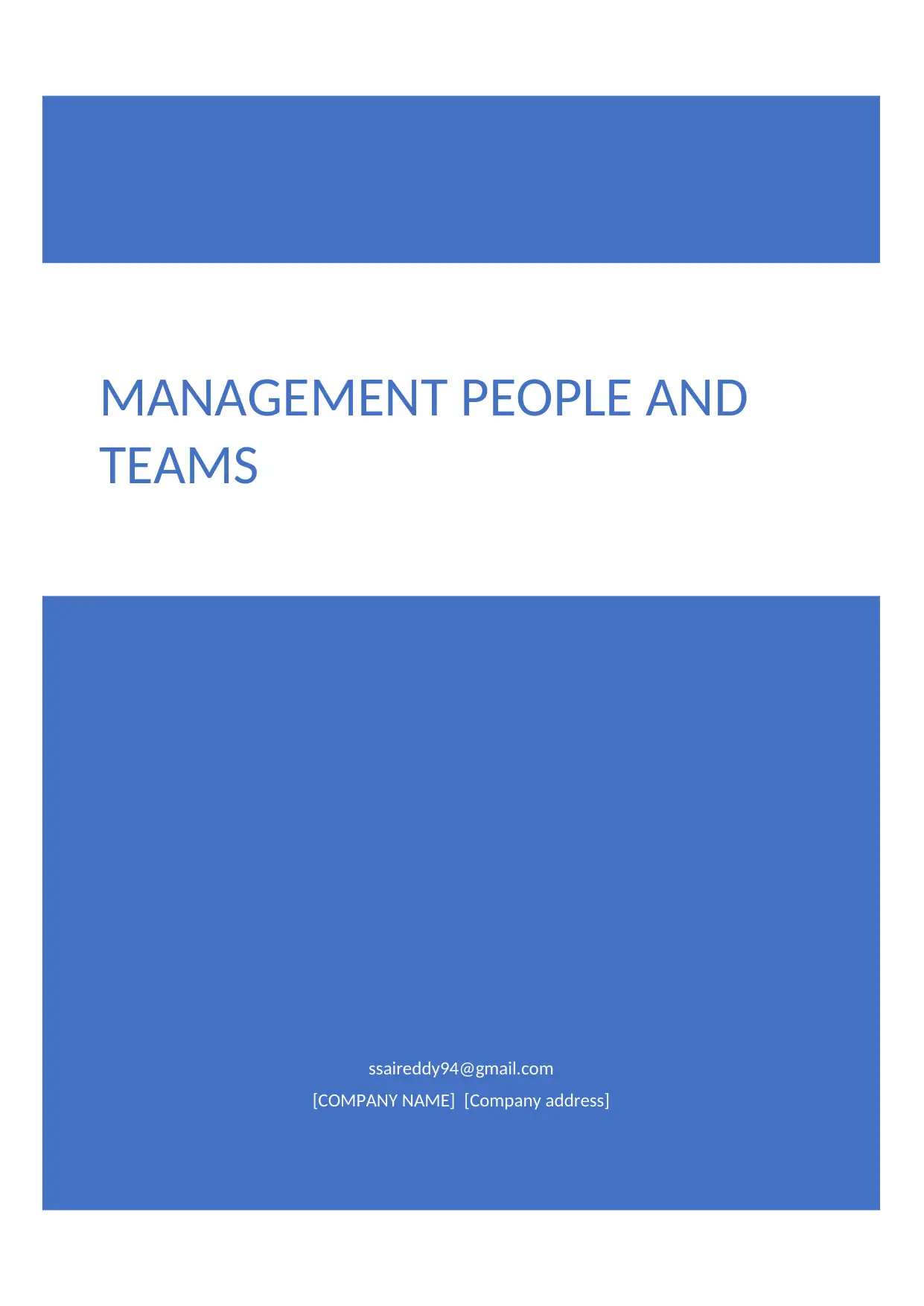
ssaireddy94@gmail.com
[COMPANY NAME] [Company address]
MANAGEMENT PEOPLE AND
TEAMS
[COMPANY NAME] [Company address]
MANAGEMENT PEOPLE AND
TEAMS
Paraphrase This Document
Need a fresh take? Get an instant paraphrase of this document with our AI Paraphraser
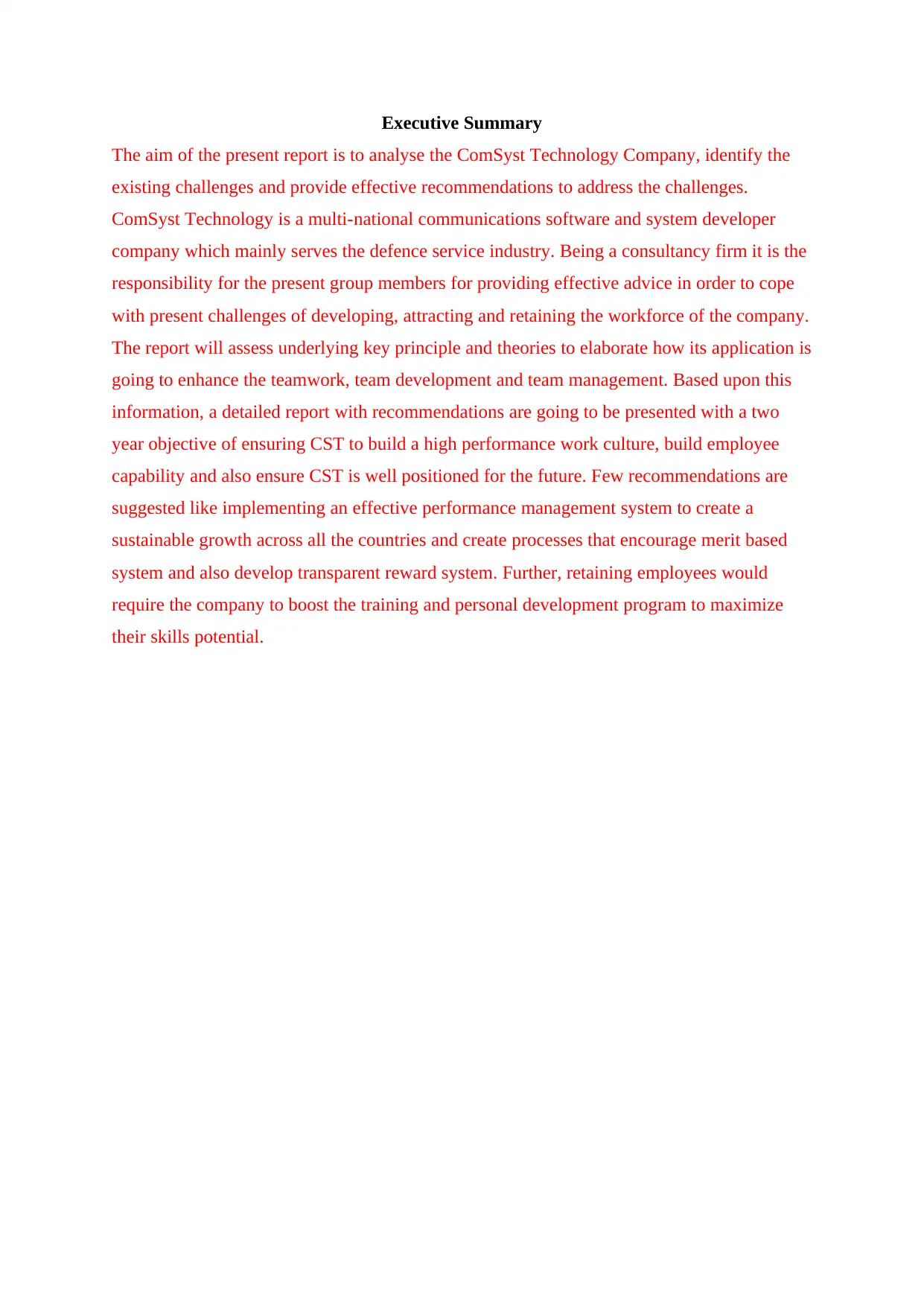
Executive Summary
The aim of the present report is to analyse the ComSyst Technology Company, identify the
existing challenges and provide effective recommendations to address the challenges.
ComSyst Technology is a multi-national communications software and system developer
company which mainly serves the defence service industry. Being a consultancy firm it is the
responsibility for the present group members for providing effective advice in order to cope
with present challenges of developing, attracting and retaining the workforce of the company.
The report will assess underlying key principle and theories to elaborate how its application is
going to enhance the teamwork, team development and team management. Based upon this
information, a detailed report with recommendations are going to be presented with a two
year objective of ensuring CST to build a high performance work culture, build employee
capability and also ensure CST is well positioned for the future. Few recommendations are
suggested like implementing an effective performance management system to create a
sustainable growth across all the countries and create processes that encourage merit based
system and also develop transparent reward system. Further, retaining employees would
require the company to boost the training and personal development program to maximize
their skills potential.
The aim of the present report is to analyse the ComSyst Technology Company, identify the
existing challenges and provide effective recommendations to address the challenges.
ComSyst Technology is a multi-national communications software and system developer
company which mainly serves the defence service industry. Being a consultancy firm it is the
responsibility for the present group members for providing effective advice in order to cope
with present challenges of developing, attracting and retaining the workforce of the company.
The report will assess underlying key principle and theories to elaborate how its application is
going to enhance the teamwork, team development and team management. Based upon this
information, a detailed report with recommendations are going to be presented with a two
year objective of ensuring CST to build a high performance work culture, build employee
capability and also ensure CST is well positioned for the future. Few recommendations are
suggested like implementing an effective performance management system to create a
sustainable growth across all the countries and create processes that encourage merit based
system and also develop transparent reward system. Further, retaining employees would
require the company to boost the training and personal development program to maximize
their skills potential.
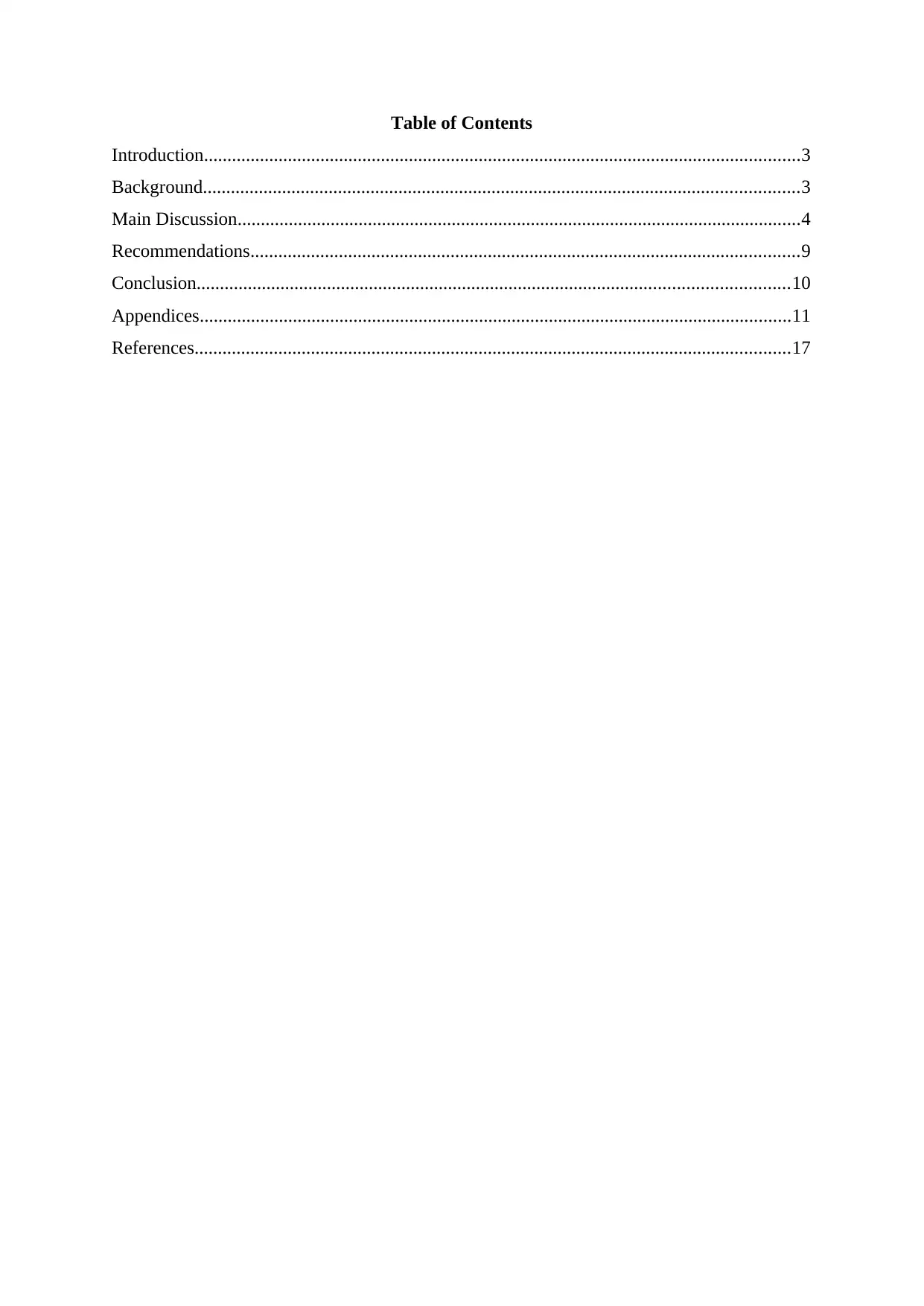
Table of Contents
Introduction................................................................................................................................3
Background................................................................................................................................3
Main Discussion.........................................................................................................................4
Recommendations......................................................................................................................9
Conclusion...............................................................................................................................10
Appendices...............................................................................................................................11
References................................................................................................................................17
Introduction................................................................................................................................3
Background................................................................................................................................3
Main Discussion.........................................................................................................................4
Recommendations......................................................................................................................9
Conclusion...............................................................................................................................10
Appendices...............................................................................................................................11
References................................................................................................................................17
⊘ This is a preview!⊘
Do you want full access?
Subscribe today to unlock all pages.

Trusted by 1+ million students worldwide
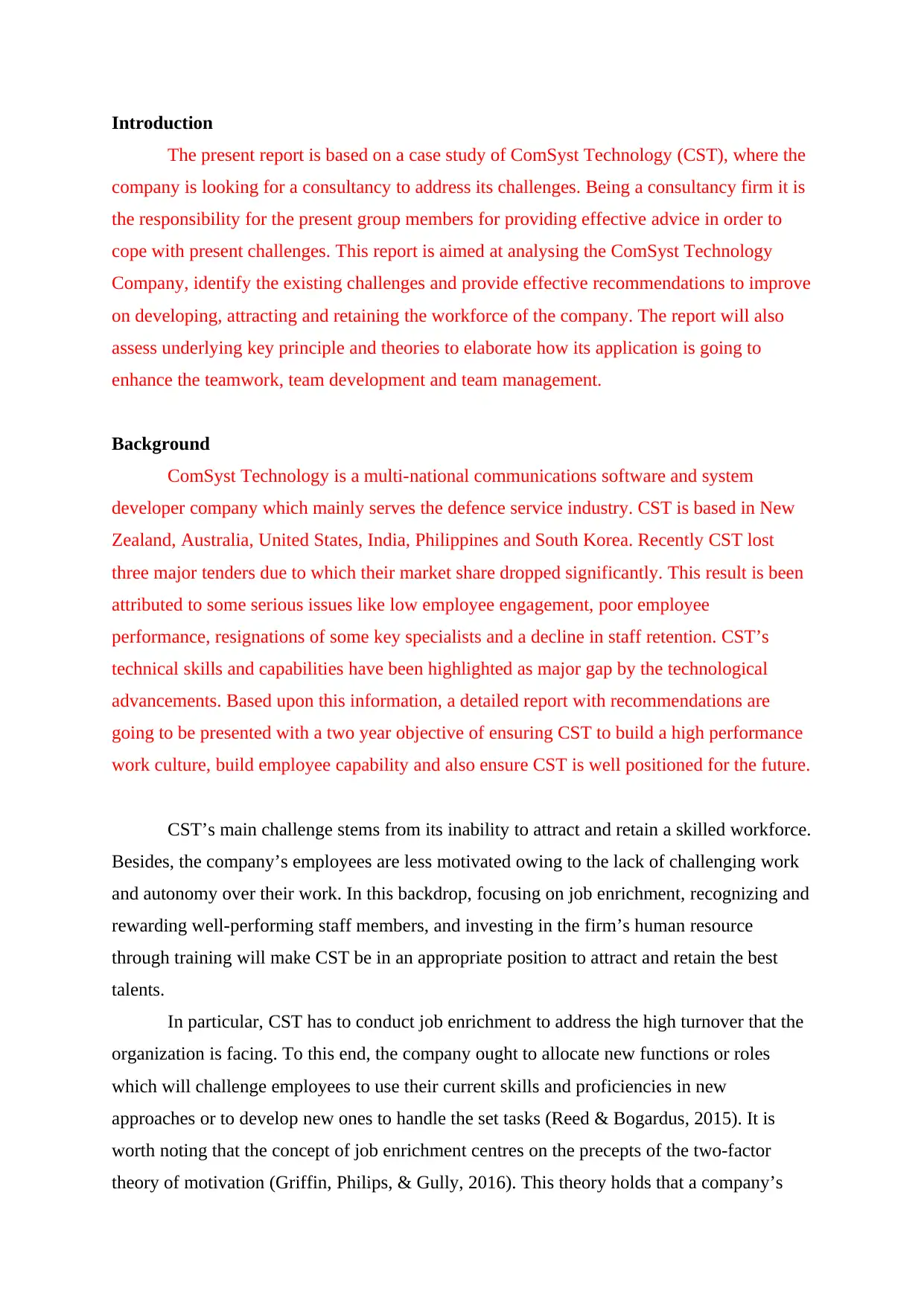
Introduction
The present report is based on a case study of ComSyst Technology (CST), where the
company is looking for a consultancy to address its challenges. Being a consultancy firm it is
the responsibility for the present group members for providing effective advice in order to
cope with present challenges. This report is aimed at analysing the ComSyst Technology
Company, identify the existing challenges and provide effective recommendations to improve
on developing, attracting and retaining the workforce of the company. The report will also
assess underlying key principle and theories to elaborate how its application is going to
enhance the teamwork, team development and team management.
Background
ComSyst Technology is a multi-national communications software and system
developer company which mainly serves the defence service industry. CST is based in New
Zealand, Australia, United States, India, Philippines and South Korea. Recently CST lost
three major tenders due to which their market share dropped significantly. This result is been
attributed to some serious issues like low employee engagement, poor employee
performance, resignations of some key specialists and a decline in staff retention. CST’s
technical skills and capabilities have been highlighted as major gap by the technological
advancements. Based upon this information, a detailed report with recommendations are
going to be presented with a two year objective of ensuring CST to build a high performance
work culture, build employee capability and also ensure CST is well positioned for the future.
CST’s main challenge stems from its inability to attract and retain a skilled workforce.
Besides, the company’s employees are less motivated owing to the lack of challenging work
and autonomy over their work. In this backdrop, focusing on job enrichment, recognizing and
rewarding well-performing staff members, and investing in the firm’s human resource
through training will make CST be in an appropriate position to attract and retain the best
talents.
In particular, CST has to conduct job enrichment to address the high turnover that the
organization is facing. To this end, the company ought to allocate new functions or roles
which will challenge employees to use their current skills and proficiencies in new
approaches or to develop new ones to handle the set tasks (Reed & Bogardus, 2015). It is
worth noting that the concept of job enrichment centres on the precepts of the two-factor
theory of motivation (Griffin, Philips, & Gully, 2016). This theory holds that a company’s
The present report is based on a case study of ComSyst Technology (CST), where the
company is looking for a consultancy to address its challenges. Being a consultancy firm it is
the responsibility for the present group members for providing effective advice in order to
cope with present challenges. This report is aimed at analysing the ComSyst Technology
Company, identify the existing challenges and provide effective recommendations to improve
on developing, attracting and retaining the workforce of the company. The report will also
assess underlying key principle and theories to elaborate how its application is going to
enhance the teamwork, team development and team management.
Background
ComSyst Technology is a multi-national communications software and system
developer company which mainly serves the defence service industry. CST is based in New
Zealand, Australia, United States, India, Philippines and South Korea. Recently CST lost
three major tenders due to which their market share dropped significantly. This result is been
attributed to some serious issues like low employee engagement, poor employee
performance, resignations of some key specialists and a decline in staff retention. CST’s
technical skills and capabilities have been highlighted as major gap by the technological
advancements. Based upon this information, a detailed report with recommendations are
going to be presented with a two year objective of ensuring CST to build a high performance
work culture, build employee capability and also ensure CST is well positioned for the future.
CST’s main challenge stems from its inability to attract and retain a skilled workforce.
Besides, the company’s employees are less motivated owing to the lack of challenging work
and autonomy over their work. In this backdrop, focusing on job enrichment, recognizing and
rewarding well-performing staff members, and investing in the firm’s human resource
through training will make CST be in an appropriate position to attract and retain the best
talents.
In particular, CST has to conduct job enrichment to address the high turnover that the
organization is facing. To this end, the company ought to allocate new functions or roles
which will challenge employees to use their current skills and proficiencies in new
approaches or to develop new ones to handle the set tasks (Reed & Bogardus, 2015). It is
worth noting that the concept of job enrichment centres on the precepts of the two-factor
theory of motivation (Griffin, Philips, & Gully, 2016). This theory holds that a company’s
Paraphrase This Document
Need a fresh take? Get an instant paraphrase of this document with our AI Paraphraser
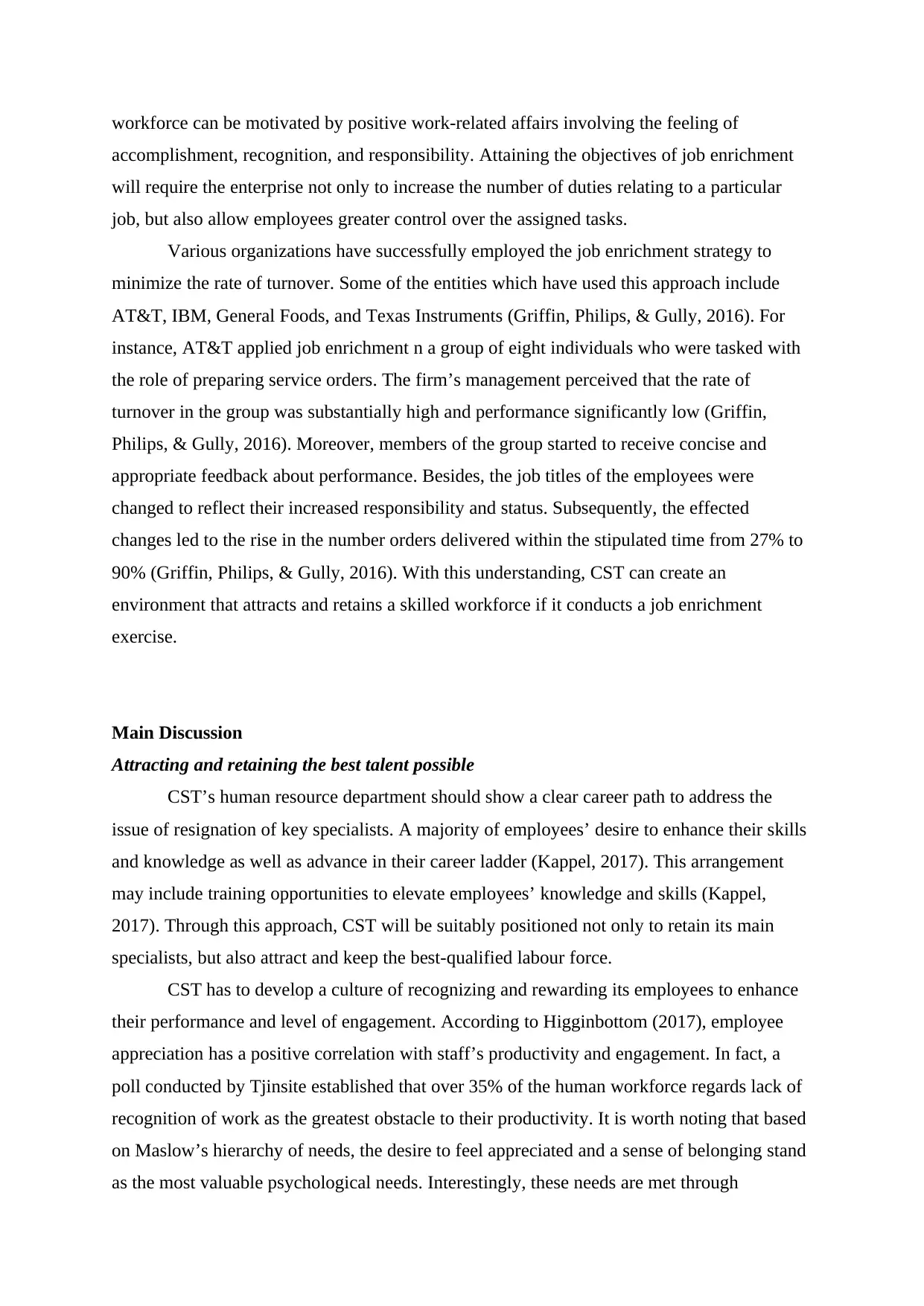
workforce can be motivated by positive work-related affairs involving the feeling of
accomplishment, recognition, and responsibility. Attaining the objectives of job enrichment
will require the enterprise not only to increase the number of duties relating to a particular
job, but also allow employees greater control over the assigned tasks.
Various organizations have successfully employed the job enrichment strategy to
minimize the rate of turnover. Some of the entities which have used this approach include
AT&T, IBM, General Foods, and Texas Instruments (Griffin, Philips, & Gully, 2016). For
instance, AT&T applied job enrichment n a group of eight individuals who were tasked with
the role of preparing service orders. The firm’s management perceived that the rate of
turnover in the group was substantially high and performance significantly low (Griffin,
Philips, & Gully, 2016). Moreover, members of the group started to receive concise and
appropriate feedback about performance. Besides, the job titles of the employees were
changed to reflect their increased responsibility and status. Subsequently, the effected
changes led to the rise in the number orders delivered within the stipulated time from 27% to
90% (Griffin, Philips, & Gully, 2016). With this understanding, CST can create an
environment that attracts and retains a skilled workforce if it conducts a job enrichment
exercise.
Main Discussion
Attracting and retaining the best talent possible
CST’s human resource department should show a clear career path to address the
issue of resignation of key specialists. A majority of employees’ desire to enhance their skills
and knowledge as well as advance in their career ladder (Kappel, 2017). This arrangement
may include training opportunities to elevate employees’ knowledge and skills (Kappel,
2017). Through this approach, CST will be suitably positioned not only to retain its main
specialists, but also attract and keep the best-qualified labour force.
CST has to develop a culture of recognizing and rewarding its employees to enhance
their performance and level of engagement. According to Higginbottom (2017), employee
appreciation has a positive correlation with staff’s productivity and engagement. In fact, a
poll conducted by Tjinsite established that over 35% of the human workforce regards lack of
recognition of work as the greatest obstacle to their productivity. It is worth noting that based
on Maslow’s hierarchy of needs, the desire to feel appreciated and a sense of belonging stand
as the most valuable psychological needs. Interestingly, these needs are met through
accomplishment, recognition, and responsibility. Attaining the objectives of job enrichment
will require the enterprise not only to increase the number of duties relating to a particular
job, but also allow employees greater control over the assigned tasks.
Various organizations have successfully employed the job enrichment strategy to
minimize the rate of turnover. Some of the entities which have used this approach include
AT&T, IBM, General Foods, and Texas Instruments (Griffin, Philips, & Gully, 2016). For
instance, AT&T applied job enrichment n a group of eight individuals who were tasked with
the role of preparing service orders. The firm’s management perceived that the rate of
turnover in the group was substantially high and performance significantly low (Griffin,
Philips, & Gully, 2016). Moreover, members of the group started to receive concise and
appropriate feedback about performance. Besides, the job titles of the employees were
changed to reflect their increased responsibility and status. Subsequently, the effected
changes led to the rise in the number orders delivered within the stipulated time from 27% to
90% (Griffin, Philips, & Gully, 2016). With this understanding, CST can create an
environment that attracts and retains a skilled workforce if it conducts a job enrichment
exercise.
Main Discussion
Attracting and retaining the best talent possible
CST’s human resource department should show a clear career path to address the
issue of resignation of key specialists. A majority of employees’ desire to enhance their skills
and knowledge as well as advance in their career ladder (Kappel, 2017). This arrangement
may include training opportunities to elevate employees’ knowledge and skills (Kappel,
2017). Through this approach, CST will be suitably positioned not only to retain its main
specialists, but also attract and keep the best-qualified labour force.
CST has to develop a culture of recognizing and rewarding its employees to enhance
their performance and level of engagement. According to Higginbottom (2017), employee
appreciation has a positive correlation with staff’s productivity and engagement. In fact, a
poll conducted by Tjinsite established that over 35% of the human workforce regards lack of
recognition of work as the greatest obstacle to their productivity. It is worth noting that based
on Maslow’s hierarchy of needs, the desire to feel appreciated and a sense of belonging stand
as the most valuable psychological needs. Interestingly, these needs are met through
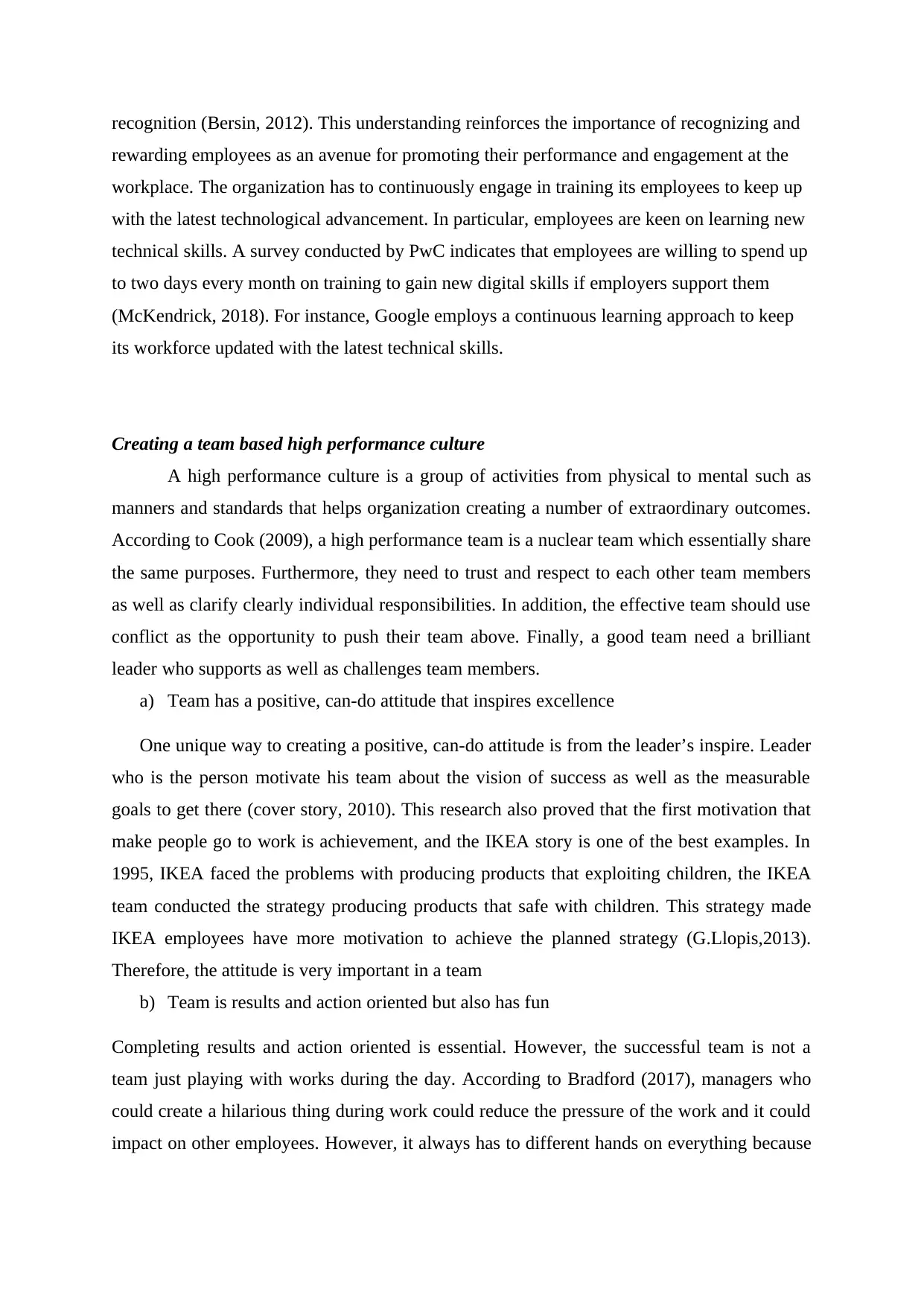
recognition (Bersin, 2012). This understanding reinforces the importance of recognizing and
rewarding employees as an avenue for promoting their performance and engagement at the
workplace. The organization has to continuously engage in training its employees to keep up
with the latest technological advancement. In particular, employees are keen on learning new
technical skills. A survey conducted by PwC indicates that employees are willing to spend up
to two days every month on training to gain new digital skills if employers support them
(McKendrick, 2018). For instance, Google employs a continuous learning approach to keep
its workforce updated with the latest technical skills.
Creating a team based high performance culture
A high performance culture is a group of activities from physical to mental such as
manners and standards that helps organization creating a number of extraordinary outcomes.
According to Cook (2009), a high performance team is a nuclear team which essentially share
the same purposes. Furthermore, they need to trust and respect to each other team members
as well as clarify clearly individual responsibilities. In addition, the effective team should use
conflict as the opportunity to push their team above. Finally, a good team need a brilliant
leader who supports as well as challenges team members.
a) Team has a positive, can-do attitude that inspires excellence
One unique way to creating a positive, can-do attitude is from the leader’s inspire. Leader
who is the person motivate his team about the vision of success as well as the measurable
goals to get there (cover story, 2010). This research also proved that the first motivation that
make people go to work is achievement, and the IKEA story is one of the best examples. In
1995, IKEA faced the problems with producing products that exploiting children, the IKEA
team conducted the strategy producing products that safe with children. This strategy made
IKEA employees have more motivation to achieve the planned strategy (G.Llopis,2013).
Therefore, the attitude is very important in a team
b) Team is results and action oriented but also has fun
Completing results and action oriented is essential. However, the successful team is not a
team just playing with works during the day. According to Bradford (2017), managers who
could create a hilarious thing during work could reduce the pressure of the work and it could
impact on other employees. However, it always has to different hands on everything because
rewarding employees as an avenue for promoting their performance and engagement at the
workplace. The organization has to continuously engage in training its employees to keep up
with the latest technological advancement. In particular, employees are keen on learning new
technical skills. A survey conducted by PwC indicates that employees are willing to spend up
to two days every month on training to gain new digital skills if employers support them
(McKendrick, 2018). For instance, Google employs a continuous learning approach to keep
its workforce updated with the latest technical skills.
Creating a team based high performance culture
A high performance culture is a group of activities from physical to mental such as
manners and standards that helps organization creating a number of extraordinary outcomes.
According to Cook (2009), a high performance team is a nuclear team which essentially share
the same purposes. Furthermore, they need to trust and respect to each other team members
as well as clarify clearly individual responsibilities. In addition, the effective team should use
conflict as the opportunity to push their team above. Finally, a good team need a brilliant
leader who supports as well as challenges team members.
a) Team has a positive, can-do attitude that inspires excellence
One unique way to creating a positive, can-do attitude is from the leader’s inspire. Leader
who is the person motivate his team about the vision of success as well as the measurable
goals to get there (cover story, 2010). This research also proved that the first motivation that
make people go to work is achievement, and the IKEA story is one of the best examples. In
1995, IKEA faced the problems with producing products that exploiting children, the IKEA
team conducted the strategy producing products that safe with children. This strategy made
IKEA employees have more motivation to achieve the planned strategy (G.Llopis,2013).
Therefore, the attitude is very important in a team
b) Team is results and action oriented but also has fun
Completing results and action oriented is essential. However, the successful team is not a
team just playing with works during the day. According to Bradford (2017), managers who
could create a hilarious thing during work could reduce the pressure of the work and it could
impact on other employees. However, it always has to different hands on everything because
⊘ This is a preview!⊘
Do you want full access?
Subscribe today to unlock all pages.

Trusted by 1+ million students worldwide
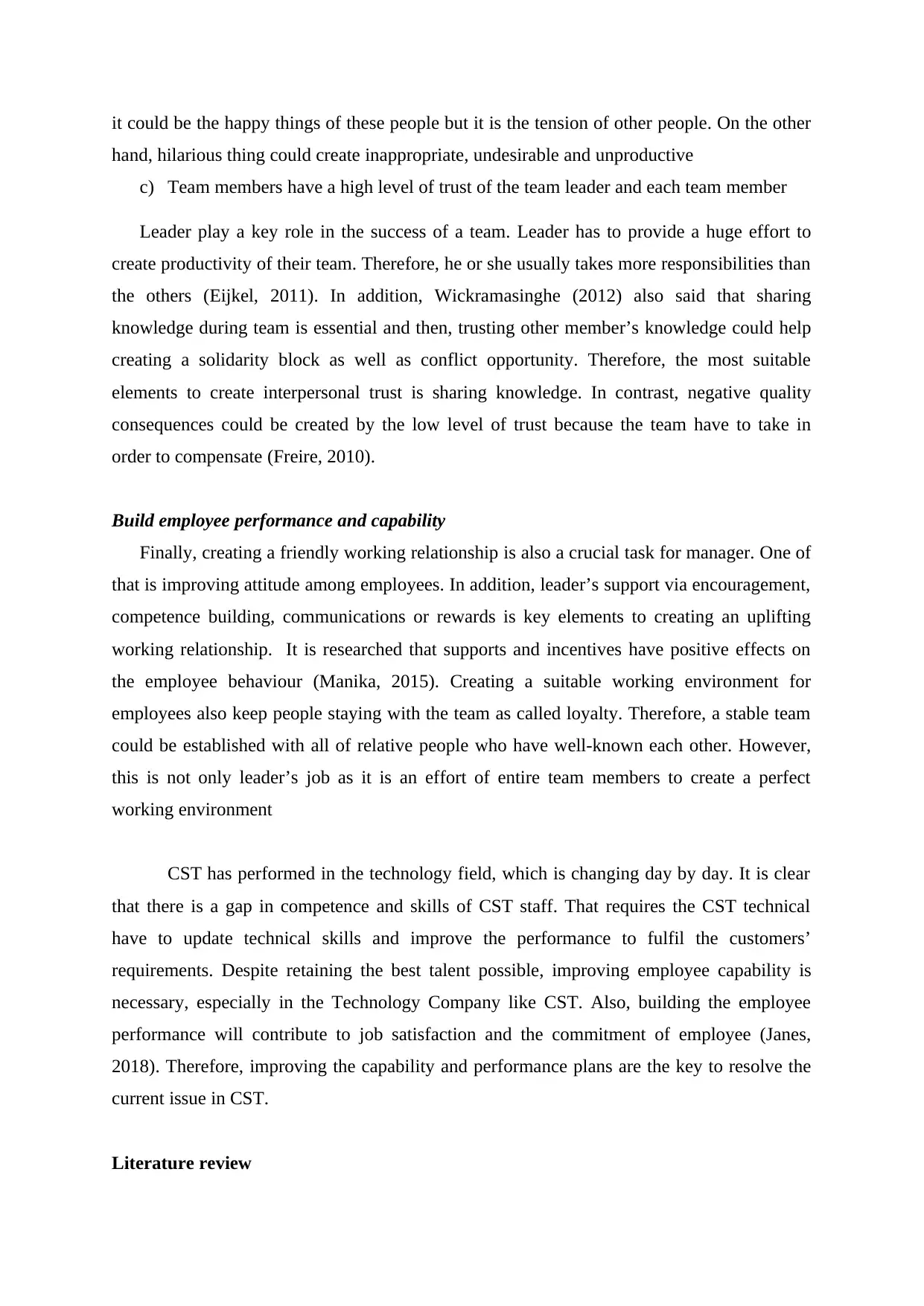
it could be the happy things of these people but it is the tension of other people. On the other
hand, hilarious thing could create inappropriate, undesirable and unproductive
c) Team members have a high level of trust of the team leader and each team member
Leader play a key role in the success of a team. Leader has to provide a huge effort to
create productivity of their team. Therefore, he or she usually takes more responsibilities than
the others (Eijkel, 2011). In addition, Wickramasinghe (2012) also said that sharing
knowledge during team is essential and then, trusting other member’s knowledge could help
creating a solidarity block as well as conflict opportunity. Therefore, the most suitable
elements to create interpersonal trust is sharing knowledge. In contrast, negative quality
consequences could be created by the low level of trust because the team have to take in
order to compensate (Freire, 2010).
Build employee performance and capability
Finally, creating a friendly working relationship is also a crucial task for manager. One of
that is improving attitude among employees. In addition, leader’s support via encouragement,
competence building, communications or rewards is key elements to creating an uplifting
working relationship. It is researched that supports and incentives have positive effects on
the employee behaviour (Manika, 2015). Creating a suitable working environment for
employees also keep people staying with the team as called loyalty. Therefore, a stable team
could be established with all of relative people who have well-known each other. However,
this is not only leader’s job as it is an effort of entire team members to create a perfect
working environment
CST has performed in the technology field, which is changing day by day. It is clear
that there is a gap in competence and skills of CST staff. That requires the CST technical
have to update technical skills and improve the performance to fulfil the customers’
requirements. Despite retaining the best talent possible, improving employee capability is
necessary, especially in the Technology Company like CST. Also, building the employee
performance will contribute to job satisfaction and the commitment of employee (Janes,
2018). Therefore, improving the capability and performance plans are the key to resolve the
current issue in CST.
Literature review
hand, hilarious thing could create inappropriate, undesirable and unproductive
c) Team members have a high level of trust of the team leader and each team member
Leader play a key role in the success of a team. Leader has to provide a huge effort to
create productivity of their team. Therefore, he or she usually takes more responsibilities than
the others (Eijkel, 2011). In addition, Wickramasinghe (2012) also said that sharing
knowledge during team is essential and then, trusting other member’s knowledge could help
creating a solidarity block as well as conflict opportunity. Therefore, the most suitable
elements to create interpersonal trust is sharing knowledge. In contrast, negative quality
consequences could be created by the low level of trust because the team have to take in
order to compensate (Freire, 2010).
Build employee performance and capability
Finally, creating a friendly working relationship is also a crucial task for manager. One of
that is improving attitude among employees. In addition, leader’s support via encouragement,
competence building, communications or rewards is key elements to creating an uplifting
working relationship. It is researched that supports and incentives have positive effects on
the employee behaviour (Manika, 2015). Creating a suitable working environment for
employees also keep people staying with the team as called loyalty. Therefore, a stable team
could be established with all of relative people who have well-known each other. However,
this is not only leader’s job as it is an effort of entire team members to create a perfect
working environment
CST has performed in the technology field, which is changing day by day. It is clear
that there is a gap in competence and skills of CST staff. That requires the CST technical
have to update technical skills and improve the performance to fulfil the customers’
requirements. Despite retaining the best talent possible, improving employee capability is
necessary, especially in the Technology Company like CST. Also, building the employee
performance will contribute to job satisfaction and the commitment of employee (Janes,
2018). Therefore, improving the capability and performance plans are the key to resolve the
current issue in CST.
Literature review
Paraphrase This Document
Need a fresh take? Get an instant paraphrase of this document with our AI Paraphraser
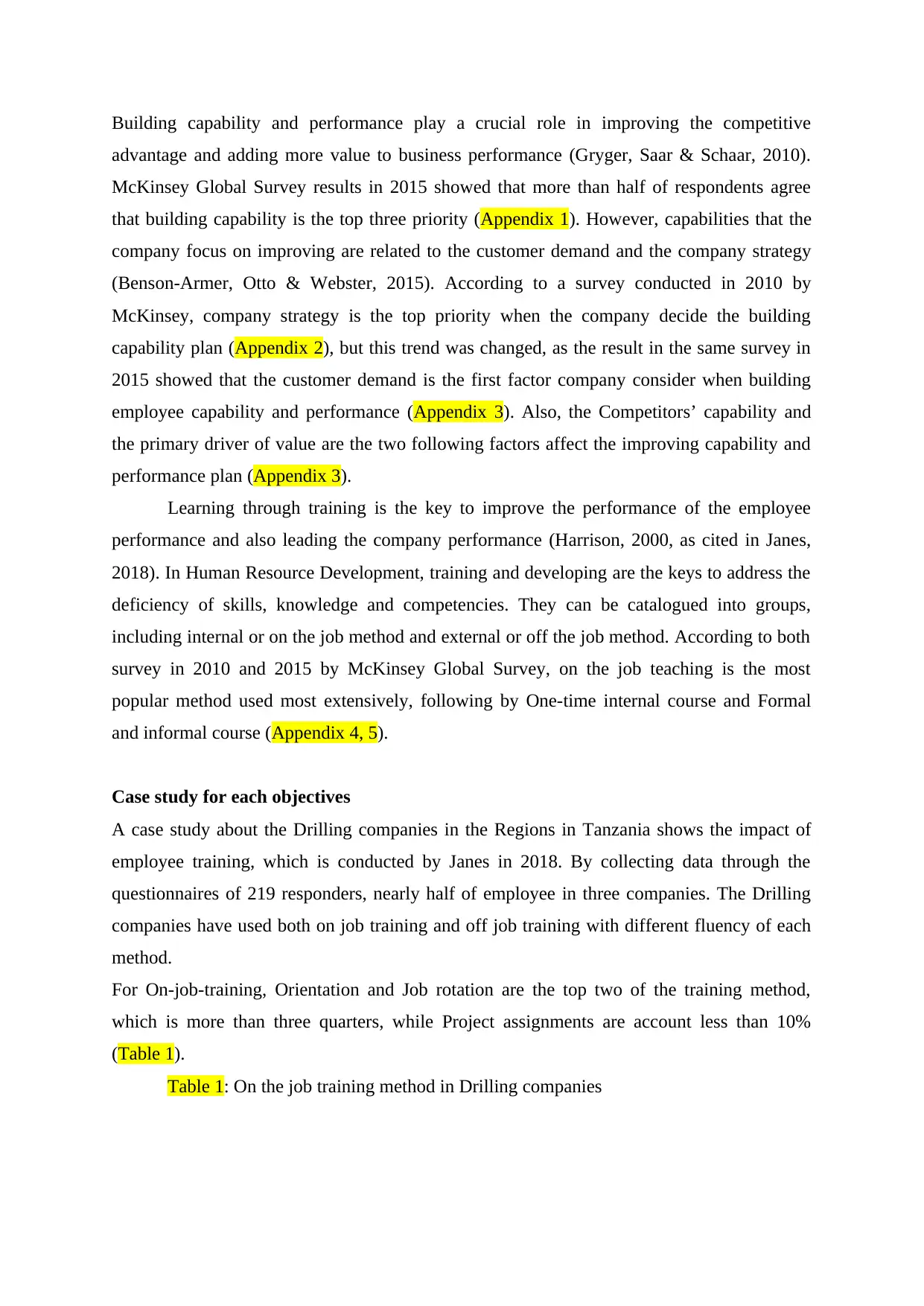
Building capability and performance play a crucial role in improving the competitive
advantage and adding more value to business performance (Gryger, Saar & Schaar, 2010).
McKinsey Global Survey results in 2015 showed that more than half of respondents agree
that building capability is the top three priority (Appendix 1). However, capabilities that the
company focus on improving are related to the customer demand and the company strategy
(Benson-Armer, Otto & Webster, 2015). According to a survey conducted in 2010 by
McKinsey, company strategy is the top priority when the company decide the building
capability plan (Appendix 2), but this trend was changed, as the result in the same survey in
2015 showed that the customer demand is the first factor company consider when building
employee capability and performance (Appendix 3). Also, the Competitors’ capability and
the primary driver of value are the two following factors affect the improving capability and
performance plan (Appendix 3).
Learning through training is the key to improve the performance of the employee
performance and also leading the company performance (Harrison, 2000, as cited in Janes,
2018). In Human Resource Development, training and developing are the keys to address the
deficiency of skills, knowledge and competencies. They can be catalogued into groups,
including internal or on the job method and external or off the job method. According to both
survey in 2010 and 2015 by McKinsey Global Survey, on the job teaching is the most
popular method used most extensively, following by One-time internal course and Formal
and informal course (Appendix 4, 5).
Case study for each objectives
A case study about the Drilling companies in the Regions in Tanzania shows the impact of
employee training, which is conducted by Janes in 2018. By collecting data through the
questionnaires of 219 responders, nearly half of employee in three companies. The Drilling
companies have used both on job training and off job training with different fluency of each
method.
For On-job-training, Orientation and Job rotation are the top two of the training method,
which is more than three quarters, while Project assignments are account less than 10%
(Table 1).
Table 1: On the job training method in Drilling companies
advantage and adding more value to business performance (Gryger, Saar & Schaar, 2010).
McKinsey Global Survey results in 2015 showed that more than half of respondents agree
that building capability is the top three priority (Appendix 1). However, capabilities that the
company focus on improving are related to the customer demand and the company strategy
(Benson-Armer, Otto & Webster, 2015). According to a survey conducted in 2010 by
McKinsey, company strategy is the top priority when the company decide the building
capability plan (Appendix 2), but this trend was changed, as the result in the same survey in
2015 showed that the customer demand is the first factor company consider when building
employee capability and performance (Appendix 3). Also, the Competitors’ capability and
the primary driver of value are the two following factors affect the improving capability and
performance plan (Appendix 3).
Learning through training is the key to improve the performance of the employee
performance and also leading the company performance (Harrison, 2000, as cited in Janes,
2018). In Human Resource Development, training and developing are the keys to address the
deficiency of skills, knowledge and competencies. They can be catalogued into groups,
including internal or on the job method and external or off the job method. According to both
survey in 2010 and 2015 by McKinsey Global Survey, on the job teaching is the most
popular method used most extensively, following by One-time internal course and Formal
and informal course (Appendix 4, 5).
Case study for each objectives
A case study about the Drilling companies in the Regions in Tanzania shows the impact of
employee training, which is conducted by Janes in 2018. By collecting data through the
questionnaires of 219 responders, nearly half of employee in three companies. The Drilling
companies have used both on job training and off job training with different fluency of each
method.
For On-job-training, Orientation and Job rotation are the top two of the training method,
which is more than three quarters, while Project assignments are account less than 10%
(Table 1).
Table 1: On the job training method in Drilling companies
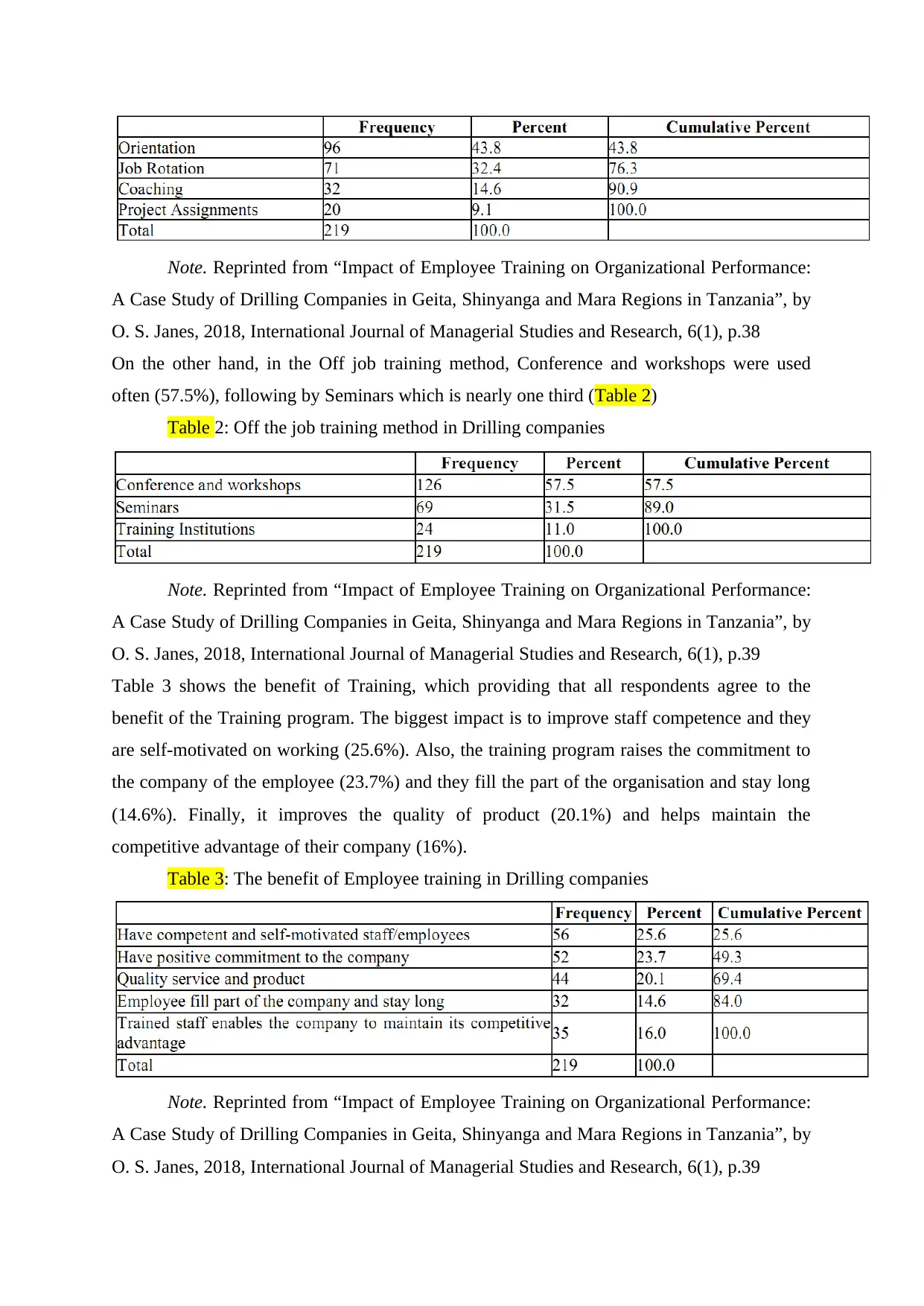
Note. Reprinted from “Impact of Employee Training on Organizational Performance:
A Case Study of Drilling Companies in Geita, Shinyanga and Mara Regions in Tanzania”, by
O. S. Janes, 2018, International Journal of Managerial Studies and Research, 6(1), p.38
On the other hand, in the Off job training method, Conference and workshops were used
often (57.5%), following by Seminars which is nearly one third (Table 2)
Table 2: Off the job training method in Drilling companies
Note. Reprinted from “Impact of Employee Training on Organizational Performance:
A Case Study of Drilling Companies in Geita, Shinyanga and Mara Regions in Tanzania”, by
O. S. Janes, 2018, International Journal of Managerial Studies and Research, 6(1), p.39
Table 3 shows the benefit of Training, which providing that all respondents agree to the
benefit of the Training program. The biggest impact is to improve staff competence and they
are self-motivated on working (25.6%). Also, the training program raises the commitment to
the company of the employee (23.7%) and they fill the part of the organisation and stay long
(14.6%). Finally, it improves the quality of product (20.1%) and helps maintain the
competitive advantage of their company (16%).
Table 3: The benefit of Employee training in Drilling companies
Note. Reprinted from “Impact of Employee Training on Organizational Performance:
A Case Study of Drilling Companies in Geita, Shinyanga and Mara Regions in Tanzania”, by
O. S. Janes, 2018, International Journal of Managerial Studies and Research, 6(1), p.39
A Case Study of Drilling Companies in Geita, Shinyanga and Mara Regions in Tanzania”, by
O. S. Janes, 2018, International Journal of Managerial Studies and Research, 6(1), p.38
On the other hand, in the Off job training method, Conference and workshops were used
often (57.5%), following by Seminars which is nearly one third (Table 2)
Table 2: Off the job training method in Drilling companies
Note. Reprinted from “Impact of Employee Training on Organizational Performance:
A Case Study of Drilling Companies in Geita, Shinyanga and Mara Regions in Tanzania”, by
O. S. Janes, 2018, International Journal of Managerial Studies and Research, 6(1), p.39
Table 3 shows the benefit of Training, which providing that all respondents agree to the
benefit of the Training program. The biggest impact is to improve staff competence and they
are self-motivated on working (25.6%). Also, the training program raises the commitment to
the company of the employee (23.7%) and they fill the part of the organisation and stay long
(14.6%). Finally, it improves the quality of product (20.1%) and helps maintain the
competitive advantage of their company (16%).
Table 3: The benefit of Employee training in Drilling companies
Note. Reprinted from “Impact of Employee Training on Organizational Performance:
A Case Study of Drilling Companies in Geita, Shinyanga and Mara Regions in Tanzania”, by
O. S. Janes, 2018, International Journal of Managerial Studies and Research, 6(1), p.39
⊘ This is a preview!⊘
Do you want full access?
Subscribe today to unlock all pages.

Trusted by 1+ million students worldwide
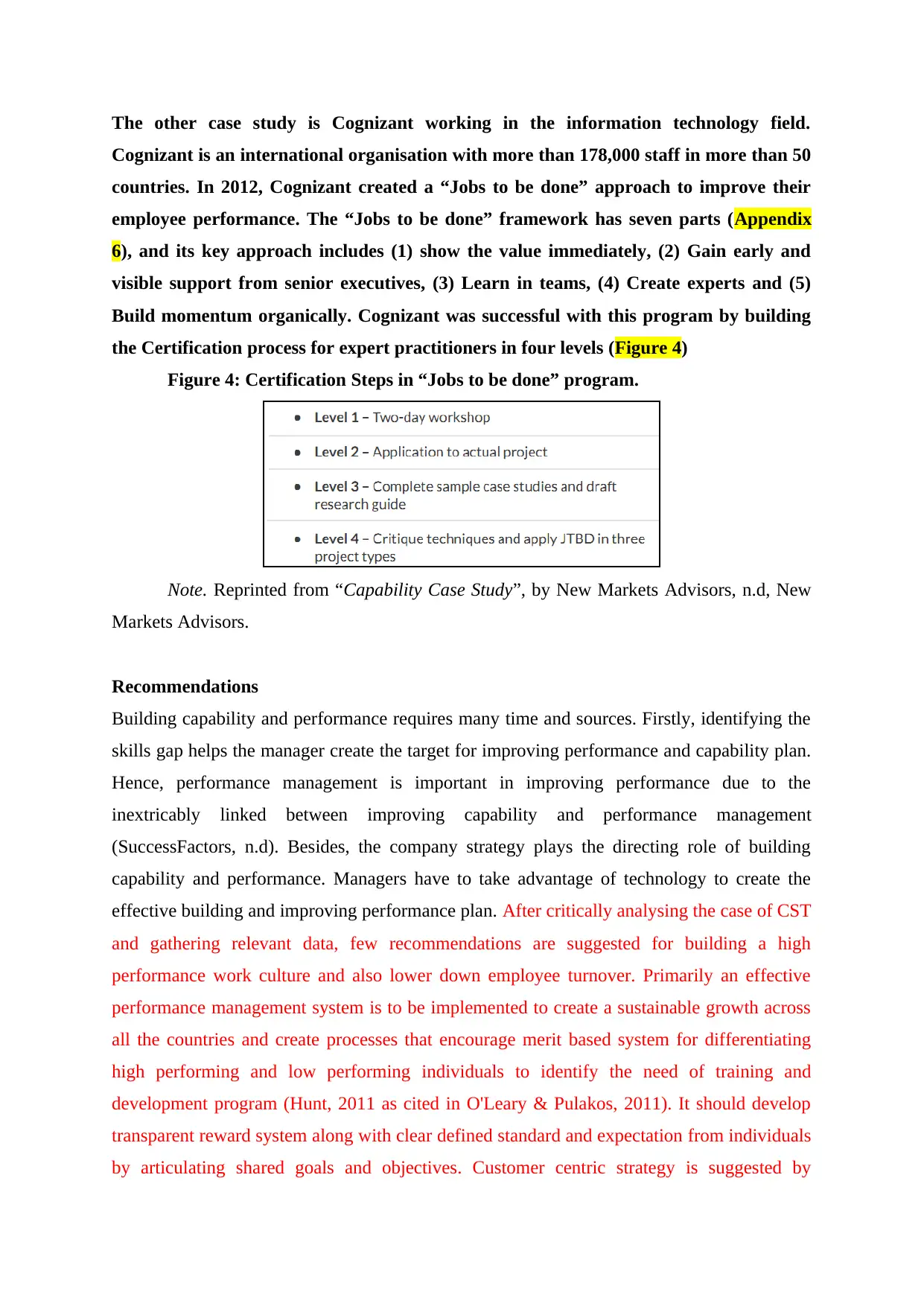
The other case study is Cognizant working in the information technology field.
Cognizant is an international organisation with more than 178,000 staff in more than 50
countries. In 2012, Cognizant created a “Jobs to be done” approach to improve their
employee performance. The “Jobs to be done” framework has seven parts (Appendix
6), and its key approach includes (1) show the value immediately, (2) Gain early and
visible support from senior executives, (3) Learn in teams, (4) Create experts and (5)
Build momentum organically. Cognizant was successful with this program by building
the Certification process for expert practitioners in four levels (Figure 4)
Figure 4: Certification Steps in “Jobs to be done” program.
Note. Reprinted from “Capability Case Study”, by New Markets Advisors, n.d, New
Markets Advisors.
Recommendations
Building capability and performance requires many time and sources. Firstly, identifying the
skills gap helps the manager create the target for improving performance and capability plan.
Hence, performance management is important in improving performance due to the
inextricably linked between improving capability and performance management
(SuccessFactors, n.d). Besides, the company strategy plays the directing role of building
capability and performance. Managers have to take advantage of technology to create the
effective building and improving performance plan. After critically analysing the case of CST
and gathering relevant data, few recommendations are suggested for building a high
performance work culture and also lower down employee turnover. Primarily an effective
performance management system is to be implemented to create a sustainable growth across
all the countries and create processes that encourage merit based system for differentiating
high performing and low performing individuals to identify the need of training and
development program (Hunt, 2011 as cited in O'Leary & Pulakos, 2011). It should develop
transparent reward system along with clear defined standard and expectation from individuals
by articulating shared goals and objectives. Customer centric strategy is suggested by
Cognizant is an international organisation with more than 178,000 staff in more than 50
countries. In 2012, Cognizant created a “Jobs to be done” approach to improve their
employee performance. The “Jobs to be done” framework has seven parts (Appendix
6), and its key approach includes (1) show the value immediately, (2) Gain early and
visible support from senior executives, (3) Learn in teams, (4) Create experts and (5)
Build momentum organically. Cognizant was successful with this program by building
the Certification process for expert practitioners in four levels (Figure 4)
Figure 4: Certification Steps in “Jobs to be done” program.
Note. Reprinted from “Capability Case Study”, by New Markets Advisors, n.d, New
Markets Advisors.
Recommendations
Building capability and performance requires many time and sources. Firstly, identifying the
skills gap helps the manager create the target for improving performance and capability plan.
Hence, performance management is important in improving performance due to the
inextricably linked between improving capability and performance management
(SuccessFactors, n.d). Besides, the company strategy plays the directing role of building
capability and performance. Managers have to take advantage of technology to create the
effective building and improving performance plan. After critically analysing the case of CST
and gathering relevant data, few recommendations are suggested for building a high
performance work culture and also lower down employee turnover. Primarily an effective
performance management system is to be implemented to create a sustainable growth across
all the countries and create processes that encourage merit based system for differentiating
high performing and low performing individuals to identify the need of training and
development program (Hunt, 2011 as cited in O'Leary & Pulakos, 2011). It should develop
transparent reward system along with clear defined standard and expectation from individuals
by articulating shared goals and objectives. Customer centric strategy is suggested by
Paraphrase This Document
Need a fresh take? Get an instant paraphrase of this document with our AI Paraphraser
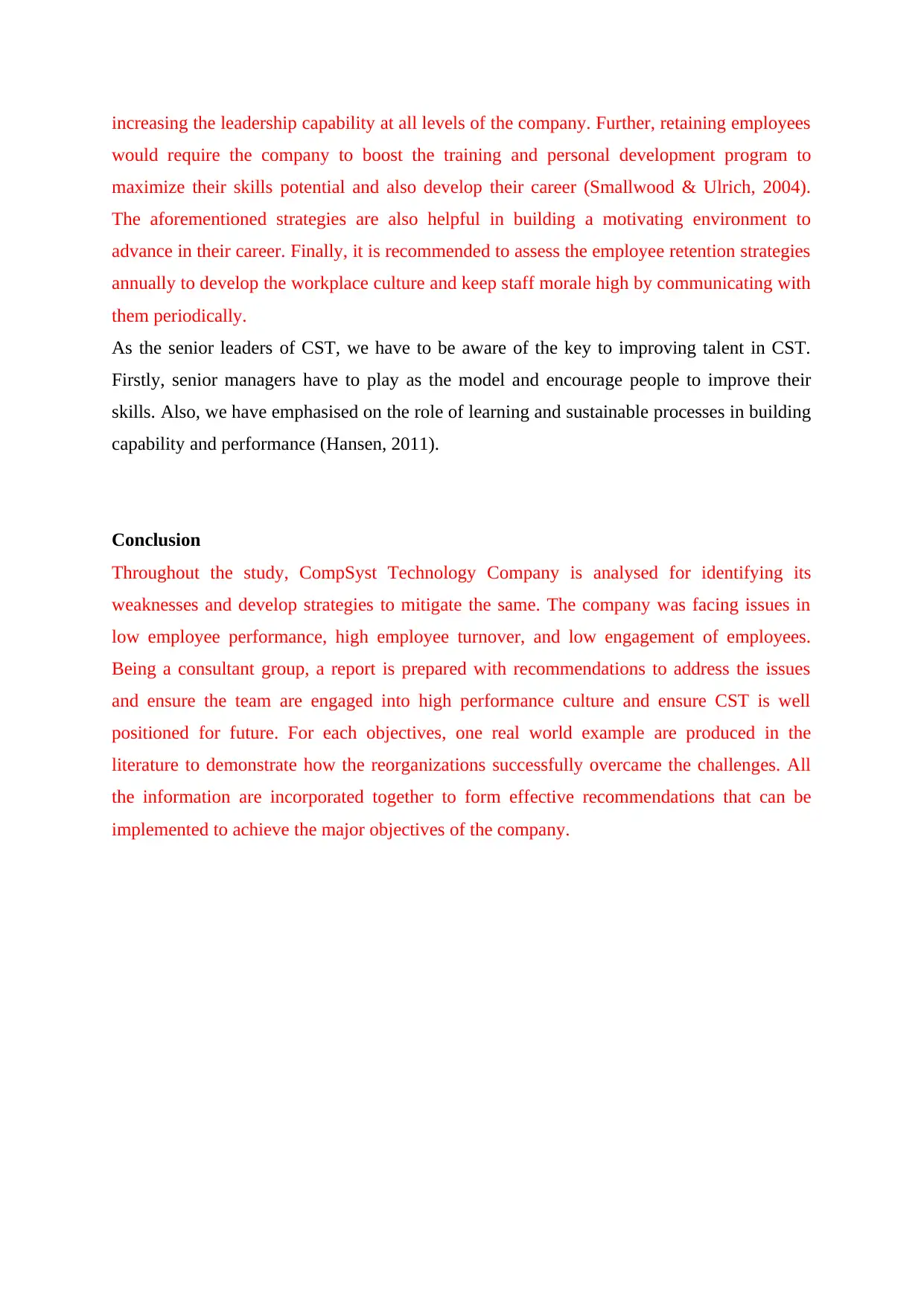
increasing the leadership capability at all levels of the company. Further, retaining employees
would require the company to boost the training and personal development program to
maximize their skills potential and also develop their career (Smallwood & Ulrich, 2004).
The aforementioned strategies are also helpful in building a motivating environment to
advance in their career. Finally, it is recommended to assess the employee retention strategies
annually to develop the workplace culture and keep staff morale high by communicating with
them periodically.
As the senior leaders of CST, we have to be aware of the key to improving talent in CST.
Firstly, senior managers have to play as the model and encourage people to improve their
skills. Also, we have emphasised on the role of learning and sustainable processes in building
capability and performance (Hansen, 2011).
Conclusion
Throughout the study, CompSyst Technology Company is analysed for identifying its
weaknesses and develop strategies to mitigate the same. The company was facing issues in
low employee performance, high employee turnover, and low engagement of employees.
Being a consultant group, a report is prepared with recommendations to address the issues
and ensure the team are engaged into high performance culture and ensure CST is well
positioned for future. For each objectives, one real world example are produced in the
literature to demonstrate how the reorganizations successfully overcame the challenges. All
the information are incorporated together to form effective recommendations that can be
implemented to achieve the major objectives of the company.
would require the company to boost the training and personal development program to
maximize their skills potential and also develop their career (Smallwood & Ulrich, 2004).
The aforementioned strategies are also helpful in building a motivating environment to
advance in their career. Finally, it is recommended to assess the employee retention strategies
annually to develop the workplace culture and keep staff morale high by communicating with
them periodically.
As the senior leaders of CST, we have to be aware of the key to improving talent in CST.
Firstly, senior managers have to play as the model and encourage people to improve their
skills. Also, we have emphasised on the role of learning and sustainable processes in building
capability and performance (Hansen, 2011).
Conclusion
Throughout the study, CompSyst Technology Company is analysed for identifying its
weaknesses and develop strategies to mitigate the same. The company was facing issues in
low employee performance, high employee turnover, and low engagement of employees.
Being a consultant group, a report is prepared with recommendations to address the issues
and ensure the team are engaged into high performance culture and ensure CST is well
positioned for future. For each objectives, one real world example are produced in the
literature to demonstrate how the reorganizations successfully overcame the challenges. All
the information are incorporated together to form effective recommendations that can be
implemented to achieve the major objectives of the company.
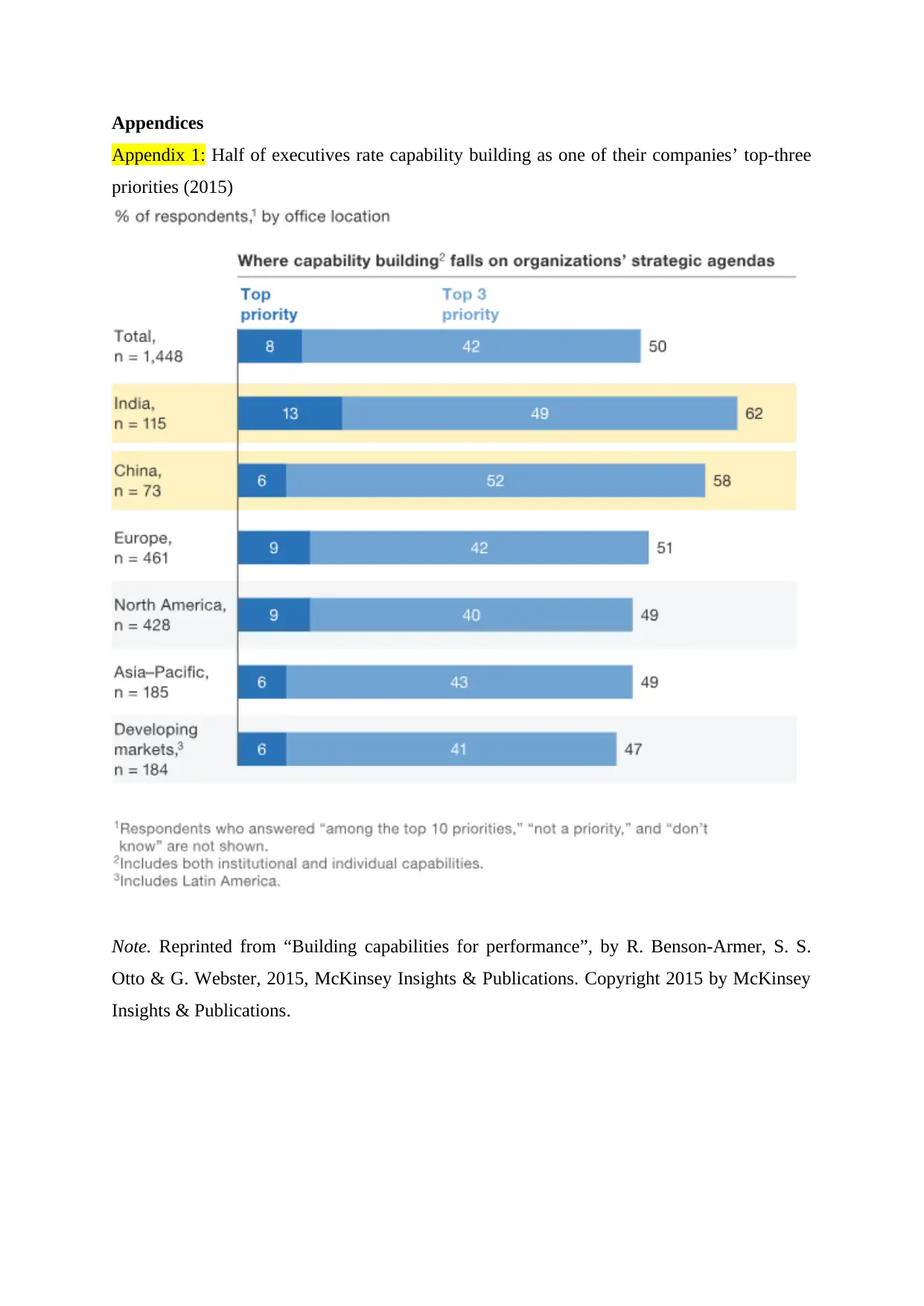
Appendices
Appendix 1: Half of executives rate capability building as one of their companies’ top-three
priorities (2015)
Note. Reprinted from “Building capabilities for performance”, by R. Benson-Armer, S. S.
Otto & G. Webster, 2015, McKinsey Insights & Publications. Copyright 2015 by McKinsey
Insights & Publications.
Appendix 1: Half of executives rate capability building as one of their companies’ top-three
priorities (2015)
Note. Reprinted from “Building capabilities for performance”, by R. Benson-Armer, S. S.
Otto & G. Webster, 2015, McKinsey Insights & Publications. Copyright 2015 by McKinsey
Insights & Publications.
⊘ This is a preview!⊘
Do you want full access?
Subscribe today to unlock all pages.

Trusted by 1+ million students worldwide
1 out of 20
Related Documents
Your All-in-One AI-Powered Toolkit for Academic Success.
+13062052269
info@desklib.com
Available 24*7 on WhatsApp / Email
![[object Object]](/_next/static/media/star-bottom.7253800d.svg)
Unlock your academic potential
Copyright © 2020–2025 A2Z Services. All Rights Reserved. Developed and managed by ZUCOL.




